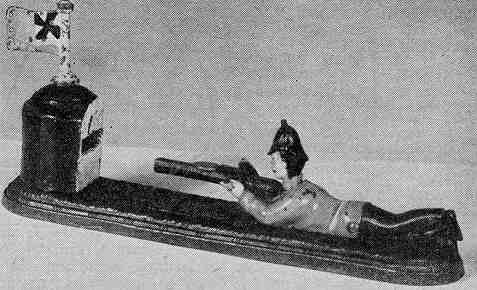Wimbledon Bank
by F.H. Griffith - HOBBIES Magazine - November, 1956

Mechanical banks that were made in England comprise an interesting group of specimens to challenge a collector. As we reach No. 50 in our numerical classification of the mechanical banks we have our first English made bank of the series, namely the Wimbledon Bank. The bank is not only an attractive rare item, but it is believed to be the earliest known mechanical bank manufactured in England.
The date of the registration of the bank is September 21, 1885, and it was made by John Harper & Company, an old line English foundry who were an active factor in their field. They made a number of different mechanical banks, but details on these and the Company itself will be covered in the future by a special article.
The bank pictured is from the fine, extensive collection of Andrew Emerine, one of the earlier collectors of mechanical banks. Mr. Emerine purchased the bank in 1939 from E.R. Harvey, a Norwich, England, antique dealer. Mr. Harvey in turn had obtained the bank from an individual who had owned it for approximately 36 years. This original owner had 12 to 14 mechanical banks that he purchased in 1903 from an old, established, wholesale toy warehouse in London. Some of these banks were old stock even at the time he purchased them in 1903. He was a mechanical toy dealer and the banks interested him so he held on to them until 1915, at which time they were all lent out to local banks for the purpose of raising funds for the Belgian Refugees Fund. A few years after this a persistent individual managed to purchase a ‘Spise a Mule’ from him. However, he apparently regretted letting it go and the longer he kept the remainder the less he was inclined to sell any others. Eventually, he let others go and finally Mr. Harvey purchased the Wimbledon Bank, John Bull Money Box, Grenadier Bank, Hoop-La Bank, and the Tank and Cannon. This was done over a period of time and the banks were purchased one at a time. Mr. Emerine was fortunate in being able to obtain all five of these banks from Mr. Harvey. Their condition is, of course, exceptionally good due to the unusual circumstances of their never having been in active circulation.
The Wimbledon is quite attractively painted. The base is green and the brown fort has the flag in red with a black cross on white ground. The prone soldier’s hat and trousers are in black trimmed with yellow. His jacket is pink with yellow cuffs and collar. The gun he is holding is black.
To operate the bank the gun is first set to fire as shown in the picture. In setting the spring operated mechanism the head of the soldier tilts slightly forward as though taking aim. A penny is then placed on the gun as shown. A small lever is then pressed and the coin is fired into the fort as the soldier snaps his head back into position.
The name Wimbledon Bank, which appears inscribed on the base, has a definite connection with the subject and action of the bank. The National Rifle Association was formed in 1860 and incorporated by Royal Charter 25 in November of 1890. The first meeting was held on Wimbledon Common in 1860 and frequent subsequent meetings were held in Wimbledon over a period of 30 years. These meetings included competition with other countries and the Queen’s Trophy was a coveted prize awarded by Queen Victoria. This was an annual award and in later years it became the King’s Trophy. Space and safety eventually were the motivating factors that caused the Association to move to Bisley in July, 1890. In addition to the Rifle Association and its connections with Wimbledon, there also existed the Second Wimbledon Volunteers Battalion of the East Surrey Regiment.
The Wimbledon Bank is a fine addition to any collection and since there are only three known to have turned up so far it offers quite a challenge to the mechanical bank collector.
